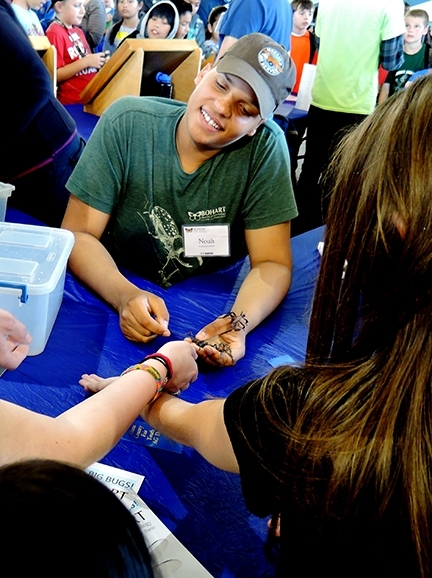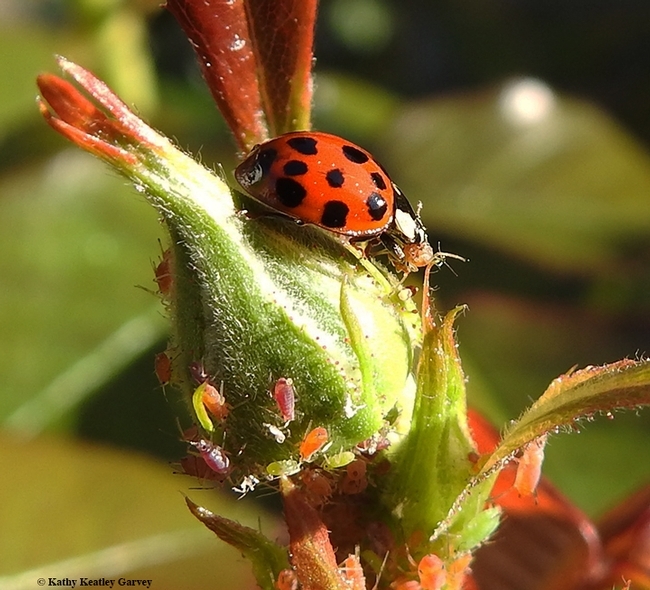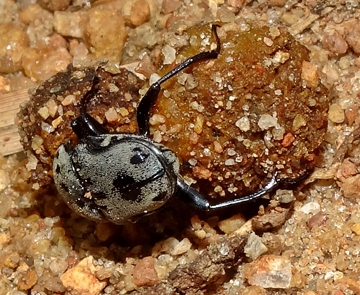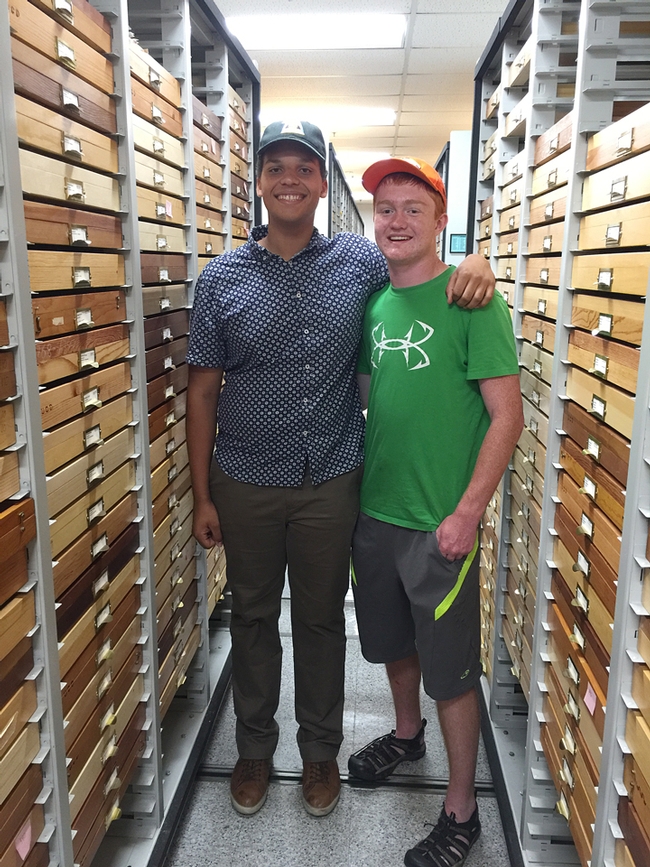
On a chance encounter, Quincy Hansen of Arvada, Colo., and Noah Crockette of Sacramento, both recipients of the global Coleopterists Society's Youth Incentive Awards, recently met for the first time. Beetle mania reigned. Reigned supreme.
Quincy, 15, won the 2016 Coleopterists Society Award, junior category, and Noah, 18, won the 2015 Coleopterists Society Award, senior category. The society launched the awards program in 1989 “to recognize young people (grades 7-12) studying beetles.”
Quincy was at UC Davis to try out for a spot on the U.S. Under 16 National Football Team roster. “If I make the team, I'll be playing football internationally for the United States,” he related. “While I was at UC Davis, I wasn't going to miss the chance to check out the entomology department and the Bohart Museum, so I stopped by.”
Said Tabatha Yang, education and outreach coordinator: “He knew all about Noah, so there was a little hero worship.”
Quincy, a 10th grader this fall at Faith Christian Academy High School, Arvada, submitted his successful grant proposal on “Survey of Coccinellidae of Adams County Colorado: Species Population Density, Seasonality, Weather Effects, Etc., Especially in Agricultural Areas.” He said his grant involves “seeing how they change throughout the summer in the presence of different variables.”
Noah's grant proposal was titled “Survey of the Dung Beetles of Stann Creek, Belize.”
Both Quincy and Noah have been interested in insects as long as they can remember.

Said Noah: “I have always been interested in bugs but my interest in entomology started in sixth grade. “I mostly became interested in insects through my internship at the Bohart and participating in the undergraduate UC Davis Entomology Club (open to all interested persons). Before then I had only known that I was interested in zoology and started going to the Ent Club after learning about it from talking to (UC Davis forensic entomologist and club advisor) Robert “Bob” Kimsey at UC Davis Picnic Day. After attending the club for awhile, Danielle Wishon (club president and entomology major) and Bob got me connected with the Bohart to start the internship from which my interest grew.”
Noah, a 2017 graduate of The Met Sacramento High School, plans to enroll in Cornell in the fall of 2018. “They gave me a one-year transfer contract so I am now spending a year at community college until I can go to Cornell in the fall of 2018,” he said. “I'm not sure exactly what I want to do career wise yet. I know for sure I want to major in entomology at Cornell. After that, I think that I would like to continue on with entomology and work in research. I also really love venom so I have also thought about going into venom research but would like to grow more familiar with it before considering it more.”
What are some of the things they've done, in and out of entomology?

Noah served as an intern for the past seven years at the Bohart Museum. He's collected insects twice in Belize on Bohart-affiliated collecting trips “where I was able to get field work experience in entomology as well as herpetology and ornithology.” The trips were led by Fran Keller, assistant professor, Folsom Lake College, and David Wyatt, an entomology professor at Sacramento City College. Keller, who holds a doctorate in entomology from UC Davis mentored Noah and showed him the ropes--along with the bugs, bats, butterflies, birds and frogs.
“My last trip to Belize was when I completed my Coleopterists Society project in which I designed and constructed 12 baited pitfall traps which I used to survey the dung beetle species on the property as well as determine their preferred bait, between human feces, pig feces, chicken manure, rotten chicken, and rotten fruit,” Noah said.
Noah's other endeavors: “I've also gotten the chance to teach an entomology class to elementary students during my freshman year and organize a museum day at Shriners Hospital for Cildren for my senior project.”
Outside of entomology, Noah's interests include hiking, kayaking and birdwatching. “I really love the outdoors,” he said. “Last year after my trip to Belize I was also given the opportunity through my school to go on a month-long backpacking and kayaking trip through the National Outdoor Leadership School (NOLS) in Alaska. I also played rugby for C.K. McClatchy High School during my senior year which was a fun experience and I now plan on continuing with the sport. At home I like to keep reptiles and invertebrates--mostly tarantulas--as pets and enjoy collecting zoology related books and objects.”
Do they have a favorite insect?
“That's a hard one,” said Quincy. “I have several that I might consider my favorite, but at the moment I'm going to say that Asbolus verrucosus - the blue death-feigning beetle, is my favorite insect.”
And Noah? “I have a tendency towards scarab beetles. I particularly like the tribe Cyclocephalini, the masked chafer beetles. “I really like that they are a Dynastines like the Hercules beetles but lack any sort of horns or other glitzy features. Even though they are small and brown, I love the subtle beauty of the markings which remind me of the Rorschach ink tests.
Lynn Kimsey, director of the museum and UC Davis professor of entomology, plans to include "The Beetle Boys' encounter at the Bohart" in her news newsletter. Coincidentally, her major professor, the late Richard M. Bohart, for whom the Bohart Museum is named, also played football--on the UC Berkeley team.
Commenting on the meeting at the Bohart: “Noah was kind enough to show me through the massive beetle collection UC Davis possesses,” Quincy said. “I feel like we bonded pretty well over a shared interest in insects, and I think we both had a good time sharing information and checking out the specimens. When we'd had our fill looking through everything from Lycids to Lucanids we moved our attention to non-beetle insects. We had a pretty good time, and Noah was, of course, very knowledgeable and kind.”
Noah delighted in meeting a fellow beetle enthusiast. “At first it was surprising to me that he knew who I am and that he was familiar with my scarab work in Belize. As I talked to Quincy more, I became very impressed with his knowledge and passion for entomology. I helped him look through the collection, and I could see how much he loves the science from the evident fact that he has studied and practiced entomology driven purely by his own interest.”
“He was very familiar with many of the groups I showed him even though he had not necessarily seen them before which further proved his continuous study of the field. Back when I applied to the Coleopterist Society Youth Incentive Award, I wondered what other high schoolers would have the interest or familiarity with the society to apply for the award," Noah said. "Meeting Quincy, I finally got to see who else would apply to the grant. I am glad to see that there are other young students who choose to immerse themselves in the field of insect research that I have learned to love so much. I am sure he will do great on his project and succeed in his future goals in the field.”
Tabatha Yang, education and outreach coordinator, said the Coleopterists Society's awards should encourage other youth to apply. Recipients hail from all over the world, from California to Kenya. The organization pledges to provide up to $600 each year.
The objectives of the Youth Incentive Award, as listed on the society's website, are to:
- provide encouragement and assistance to young beetle enthusiasts (grades 7-12).
- promote the study of beetles, the most diverse group of insects, as a rewarding lifelong avocation or career.
- provide opportunities for young people to develop important life skills such as leadership, cooperation, communication, planning and conducting a scientific study, grant writing and managing funds.
- provide some financial support to enrich activities or projects.
Attached Images:
